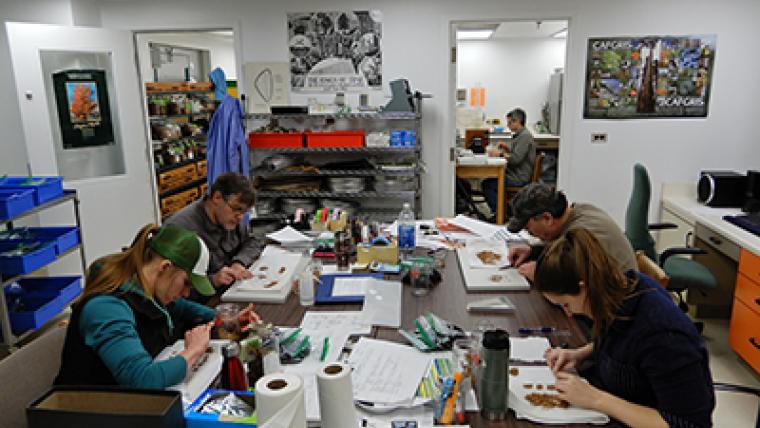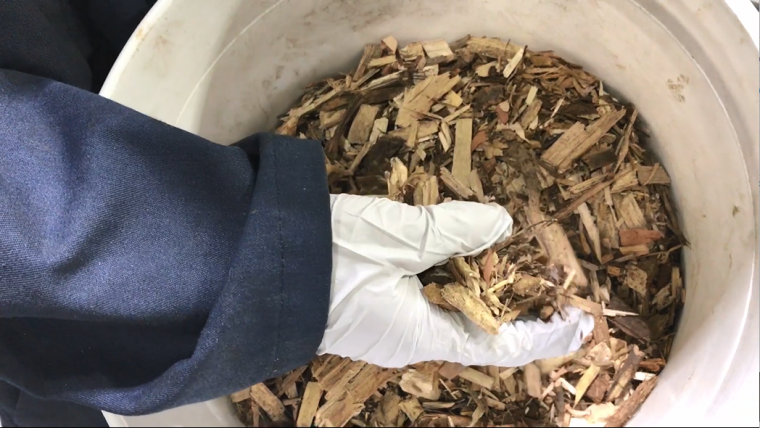Citizen scientist spots a newcomer on Canadian elm trees
September 2020
By Véronique Martel, Ph.D. - research scientist in entomology, Natural Resources Canada, Laurentian Forestry Centre
Many community science websites invite people to post photos of wildlife sightings. This may seem like a small gesture, but in the summer of 2020, such observations led to the detection — for the first time in North America — of a new exotic insect attacking elm trees: the elm zigzag sawfly.
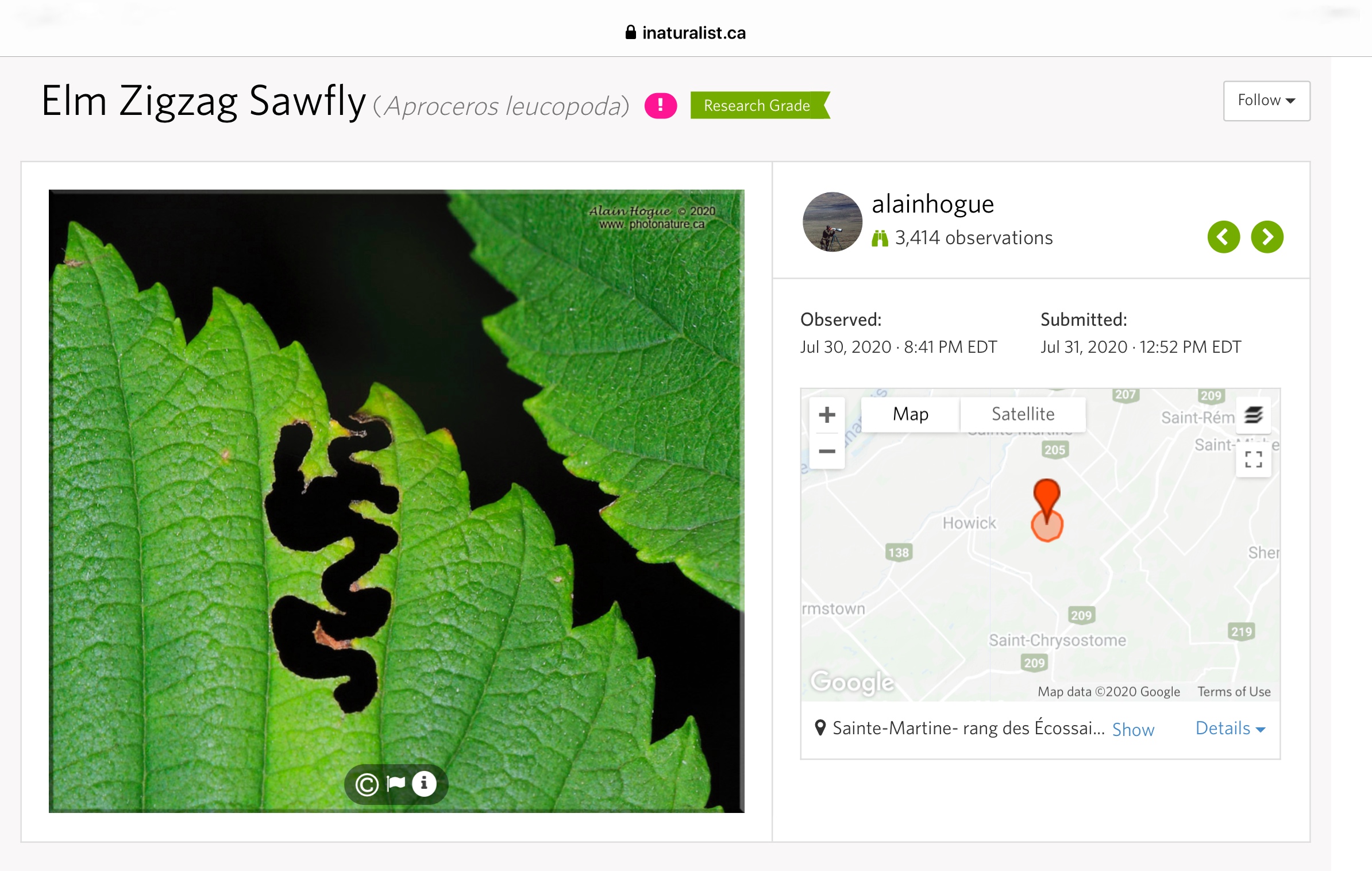
The original post on iNaturalist that alerted the scientific community.
It all began in late July, when nature photographer Alain Hogue saw a zigzag shape in an elm eaf on the side of a road in Quebec. He published the photo on the iNaturalist website. What he couldn’t predict was that this simple photo would trigger a cascade of emails and field visits! An American expert quickly identified the zigzag defoliation pattern as having been caused by a sawfly. And through an email to a European expert, the first tentative identification of the elm zigzag sawfly was made.
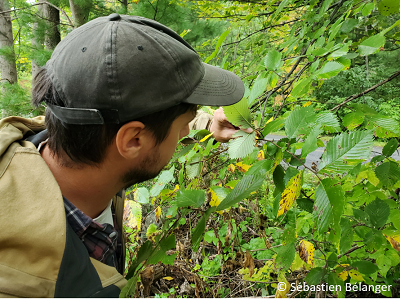
CFS technician Simon Trudeau examines elm leaves for the elm zigzag sawfly.

Véronique Martel, research scientist and entomologist.
Word of this invasive pest spread quickly
A flurry of emails followed, notifying various organizations such as the Canadian Food Inspection Agency (CFIA), the organization responsible for detecting and regulating new exotic organisms. I was also notified at the Canadian Forest Service (CFS). A few weeks and two field visits later, official confirmation from the CFIA arrived: the elm zigzag sawfly is present in Canada. Several other observations of the insect have since been reported in Quebec on the iNaturalist website. In these times of pandemic where teleworking is the rule, citizen science is more precious than ever!
What is the elm zigzag sawfly?

An adult elm zigzag sawfly. Source: Danail Doychev
What is this newcomer? The elm zigzag sawfly, Aproceros leucopoda, is an insect of the Hymenoptera order — meaning, with four transparent wings — belonging to the same group as ants, bees and wasps. It attacks elms and is naturally present in Asia. However, since at least 2003, it is also present in Europe. It is therefore not surprising to find it now in Canada. Although it’s not known exactly how it got here, my colleague Michel Cusson, a researcher in insect physiology and biochemistry at the CFS, will try to answer this question using molecular techniques.
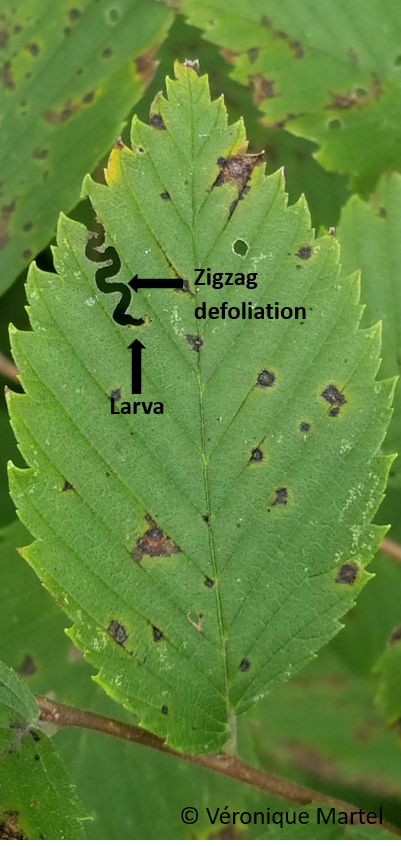
An elm leaf showing zigzag defoliation and a small larva feeding.
The elm zigzag sawfly lays its eggs on the edge of elm leaves. The small larva, after hatching, will feed on the leaf in a characteristic zigzag between two veins. As it grows, the larva will stop feeding in this distinctive pattern and may eventually defoliate the entire leaf, leaving only the central vein. It will then form a cocoon under the leaf. This cocoon is easy to identify, since its mesh is loose and therefore allows the insect to be seen inside, and the now mature adult will come out after a few days. Some of these cocoons, slightly different, are called “winter cocoons.” They’re tighter and stronger, offering better protection, and they’re found on the ground where they spend the winter under the snow. The adult emerges the following spring, after the snow melts and temperatures become warmer.
Why so much success away from home?
The elm zigzag sawfly is very successful in its area of introduction for a number of reasons. First, its life cycle is very fast, the time between egg laying and adult emergence being less than a month. This allows several generations in a year, and with each generation the population increases. Secondly, females do not need to mate to lay their eggs, a phenomenon called parthenogenesis. This allows females to lay their eggs sooner, without first finding a sexual partner. Finally, the adult seems to be able to travel great distances by itself. A European study suggests that the species can spread at a speed of about 45–90 kilometres per year. This means they can disperse quite rapidly into a new territory.
What's next?
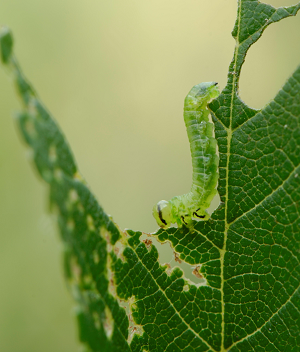
As larvae grow and develop, they completely consume the entire leaf, except for the leaf mid-rib. Source: Danail Doychev.
We don’t know yet how long the insect has been present, how it arrived, or how it will behave here. But one thing is certain: my team, in collaboration with the CFIA and various organizations here and in Europe, is already working on this task. Although autumn brings the field season to its end, our team is already preparing for the 2021 field season in order to determine the insect’s range, seasonality, the possible presence of natural enemies and any other relevant aspects of its biology. In the meantime, Michel Cusson’s team will try to determine where it came from.
More details will follow in the coming years to better understand the elm zigzag sawfly, this new exotic insect discovered in the summer of 2020 in Quebec!
- Contact Véronique Martel, Ph.D., veronique.martel@canada.ca
- Canadian Food Inspection Agency website
Page details
- Date modified:
